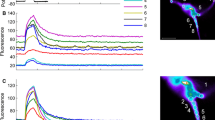Abstract
The electrical signals of nerve and muscle are fundamentally dependent on the voltage-gated Na+ channel, which is responsible for the rising phase of the action potential. At least two kinds of Na+ channel are expressed in the membrane of frog dorsal root ganglion (DRG) cells: Na+ channels with fast kinetics that are blocked by tetrodotoxin (TTX) at high affinity, and Na+ channels with slower kinetics that are insensitive to TTX. Recordings of single-channel currents from frog DRG cells, under conditions favoring Na+ as the charge carrier, reveal two distinct amplitudes of single-channel events. With 300 mM external Na+, single-channel events that can be measured in the presence of 1 μM TTX have a slope conductance 7.5 pS. In the absence of TTX, events with a slope conductance of 14.9 pS dominate. Ensemble averages of the smaller single-channel events display the slower kinetics characteristic of the macroscopic TTX-insensitive Na+ currents, and ensemble averages of the larger events display the faster kinetics characteristic of the TTX-sensitive currents. The results are consistent with the idea that the toxin-binding site is sufficiently close to the pore to influence ion permeation.
Similar content being viewed by others
References
Adrian RH, Chandler WK, Hodgkin AL (1970) Voltage clamp experiments in striated muscle fibers. J Physiol (Lond) 208:607–644
Brown AM, Lee KS, Powell T (1981) Sodium current in single rat heart muscle cells. J Physiol (Lond) 318:479–500
Campbell DT (1988) Differential expression of Na channel subtypes in two populations of sensory neurons (abstract). Biophys J 53:15 a
Campbell DT (1990) Current through single TTX-sensitive and TTX-resistant Na channels in frog DRG cells (abstract). Biophys J 57:103 a
Campbell DT (1992) Large and small vertebrate sensory neurons express different Na and K channel subtypes. Proc Natl Acad Sci USA 89:9569–9573
Campbell DT, Hille B (1976) Kinetic and pharmacological properties of the sodium channel of frog skeletal muscle. J Gen Physiol 67:309–323
Colquhoun D, Sigworth FJ (1983) Fitting and statistical analysis of single-channel records. In: Neher E, Sakmann B (eds) Single-channel recording. Plenum Press, New York
Frank TM, Campbell DT (1991) Permethrin prolongs sodium channel tail currents in trout sensory neurons (abstract). Biophys J 59:259 a
Guy HR, Conti F (1990) Pursuing the structure and function of voltage-gated channels. Trends Neurosci 13:201–206
Hamill OP, Marty A, Neher E, Sakmann B, Sigworth FJ (1981) Improved patch-clamp techniques for high-resolution current recording from cells and cell-free membrane patches. Pflügers Arch 391:85–100
Harris JB, Thesleff S (1971) Studies on tetrodotoxin resistant action potentials in denervated skeletal muscle. Acta Physiol Scand 83:382–388
Hille B (1966) Common mode of action of three agents that decrease the transient change in sodium permeability in nerves. Nature (Lond) 210:1220–1222
Hodgkin AL (1975) The optimum density of sodium channels in an unmyelinated nerve. Philos Trans R Soc Lond [Biol] 270:297–300
Jones SW (1987) Sodium currents in dissociated bull-frog sympathetic neurones. J Physiol (Lond) 389:605–627
Kostyuk PG, Veselovsky NS, Tsyndrenko AY (1981) Ionic currents in the somatic membrane of rat dorsal root ganglion neurons. I. Sodium currents. Neuroscience 6:2423–2430
Narahashi T (1974) Chemicals as tools in the study of excitable membranes. Physiol Rev 54:813–889
Narahashi T, Moore JW, Scott WR (1964) Tetrodotoxin blockage of sodium conductance increase in lobster giant axons. J Gen Physiol 47:965–974
Noda M, Suzuki H, Numa S, Stühmer W (1989) A single point mutation confers tetrodotoxin and saxitoxin insensitivity on the sodium channel II. FEBS Lett 259:213–216
Pappone PA (1980) Voltage-clamp experiments in normal and denervated mammalian skeletal muscle fibres. J Physiol (Lond) 306:377–410
Press WH, Flannery BP, Teukolsky SA, Vetterling WT (1986) Numerical recipes — the art of scientific computing. Cambridge University Press, Cambridge
Sigworth FJ, Spalding BC (1980) Chemical modification reduces the conductance of sodium channels in nerve. Nature (Lond) 283:293–295
Spalding BC (1980) Properties of toxin-resistant sodium channels produced by chemical modification in frog skeletal muscle. J Physiol (Lond) 305:485–500
Terlau H, Heinemann SH, Stühmer W, Pusch M, Conti F, Imoto K, Numa S (1991) Mapping the site of block by tetrodotoxin and saxitoxin of sodium channel II. FEBS Lett 293:93–96
Weiss RE, Horn R (1986) Functional differences between two classes of sodium channels in developing rat skeletal muscle. Science 233:361–364
Author information
Authors and Affiliations
Rights and permissions
About this article
Cite this article
Campbell, D.T. Single-channel current/voltage relationships of two kinds of Na+ channel in vertebrate sensory neurons. Pflügers Arch. 423, 492–496 (1993). https://doi.org/10.1007/BF00374946
Received:
Revised:
Accepted:
Issue Date:
DOI: https://doi.org/10.1007/BF00374946




